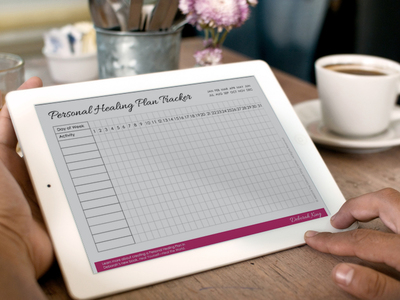Stay on Track: A Personal Healing Action Plan

Healing is a marathon, not a sprint. Whether you are five minutes or five years into your healing journey, it’s easy to get distracted and wander off the path – especially when the world around you is in chaos.
In my book Heal Yourself—Heal the World, I dedicate an entire chapter to teaching you the basics of a Personal Healing Plan. Students often get bogged down with complex concepts, like chakras and mind/body types, and forget that simple lifestyle changes can make a big difference in their personal energy field.
Living a healthy and balanced life is one of the best things you can do to protect and heal yourself. Doing things like getting enough rest and dedicating time to process emotions, eating clean food that nourishes your body, and spending time with people who lift you up (rather than depress you and bring you down), are all things you can do give yourself a leg up on the healing ladder.
All of the practices I write about below will nourish your body, mind, and spirit…if you make them a habit in your self-care routine. Over the years, the number one thing that the majority of my students struggle with is dedicating time for their self-care; this is not surprising considering there are so many things competing for their time and attention. To keep your healing goals front and center (and to see your progress over time), think about adding a monthly activity tracker page to your journal. You can create your own (there is no shortage of fun designs and ideas on Pinterest) or download a copy of my Personal Healing Plan Tracker.
The activities that you include in your Personal Healing Plan Tracker will be unique to you, however, there are some universal basic practices that you should use as guidelines. Think about the practices below and think about how you can incorporate them into your self-care routine and Personal Healing Plan Tracker.

Download your free Personal Healing Habit Tracker today
Basic practices for personal healing
Good food
A new day, a new diet (or so it seems). As a general rule, diets are created by companies that want to sell you a product, be it supplements or shakes. The truth of the matter is that the foods that work best for you are completely dependent on your unique makeup.
We are all different, but there are a few basic rules to follow that will point you in a healthier direction:
- Choose real food that is not processed whenever possible. Stick to the perimeter of the grocery store: fruits, vegetables, eggs, fish, poultry, dairy, and whole grain bread.
- Drink plenty of pure water. You need about a quart a day just to replace the water that your body loses by breathing!
- “Nonfoods” should be avoided at all costs. Think: processed foods in boxes or bags that have preservatives; canned items, especially tomatoes, that do not specifically say BPA is not used in the lining of the can; genetically modified and foods that are microwaved – your body doesn’t recognize these “nonfood” items and doesn’t know what to do with them.
- Chemicals and pesticides are a problem. Whenever possible, opt for organic. (Note: you should also be mindful about the personal care products you put on your body. In the United States, lotions, fragrances, deodorants/antiperspirants, makeup, and hair styling products do not go through any regulatory approval process. Your body absorbs 60% of everything you put on it and I doubt you’d be okay with absorbing 60% of the lead in your signature red lipstick – no brands will be mentioned, but a quick Google search will reveal a Mother Jones investigation.)
- Use of nicotine, alcohol, recreational and prescription drugs increase the body’s toxic load.
- Opt for small frequent meals that contain protein if you are over 30 years old and/or are stressed; every two hours is ideal.
Exercise
Your body’s health is dependent on moving it. And you don’t need to start training for a marathon to get enough exercise: studies have shown that walking briskly every day can reduce a woman’s chance of getting diabetes breast cancer, and heart disease.
Here are some tips for exercising to support your body:
- Exercise that requires focused and conscious movement (Quigong, T’ai chi, Pilates, yoga) give your muscles and brain a workout.
- Go outdoors for part of your exercise. If you’re a gym or class fan, that’s fine but changing it up every once in a while (go to an outdoor yoga class or walk in the park instead of on the treadmill) will help you connect to nature.
- Aim for a minimum of 20 minutes of exercise every day. Build it into your Personal Healing Plan Tracker and do your best to check off those boxes. Even a quick walk during your lunch break, taking the stairs, or parking further away from the building count.
Meditation
There are so many benefits to meditation that I’m always surprised that not everyone does it. It puts you in the present moment, relaxes your body and mind, washes away your stress, bolsters your intuitive abilities, and even makes you look and feel younger (take that expensive wrinkle creams!). Twenty minutes morning and evening are ideal.
Sleep
Sleep is one of those things that everyone struggles with at some point in their lives, be it getting too much or too little.
How much sleep do you need? Just like your diet, this also depends on your individual makeup. If you wake to an alarm clock, try going to bed ten minutes earlier each night until you wake up before the alarm rings.
You should also be conscious about using light-emitting devices before bed (sorry, turning on the dimming feature on your iPhone doesn’t make it an exception). Electronic devices have a higher concentration of blue light vs. natural light – and this impacts the levels of melatonin that your body produces. In short, you’re playing Russian roulette with your body’s natural circadian rhythm clock – and this can have devastating health effects beyond just not being able to fall asleep.
Connect with other people and creaturesContemporary Western culture – especially American culture – is extremely isolating. In contrast to American culture where children are expected to move out at 18 (and if they don’t, are considered unsuccessful), in many other parts of the world, such as Southeast Asia and Russia, it’s normal for entire families to live together, even when children are grown.
And while technology has allowed us to connect with family and friends that live far away, when you are out with family and friends put the phone down! How many times have you watched two people sit at dinner completely absorbed in their phone? It’s no surprise that we feel disconnected, alone, lonely, and isolated; we are social creatures and have an innate desire to be part of a community.
If you live alone (as many people do these days), consider adding a pet to your life. We need physical contact as well as social, and I’ve never met a dog that didn’t jump at the chance to sit on their owner’s lap.
Laugh
The world we live in is extremely chaotic, which results in instability and stress on society. Don’t ignore atrocities, but don’t be consumed by them either. For example, watch Seinfeld or The Big Bang Theory instead of the six o’clock news when you come home from a long day. Laughter is good for the body and the soul; it relieves stress and boosts immune functioning.
As much as possible, go to bed happy.
Challenge yourself
We all have bucket lists – and if you don’t, whip out that journal of yours and get planning! Keep in mind that your bucket list doesn’t have to be exotic and crazy, like skydiving or hiking Machu Picchu. Some of my students have confided that their number one bucket list item was to overcome an eating disorder or free themselves from a particular medication.
Essentially a bucket list is a set of goals you would like to achieve in your lifetime. By identifying long-term goals, you can begin identifying obstacles that sit in the middle of your path (either right now or in the future). A bucket list that you plan and work toward will challenge you and magnify your own personal healing power many times over.
For a complete guide to building out your Personal Healing Action Plan, check out Chapter 15 of my new book Heal Yourself—Heal the World. If you haven’t ordered your copy yet, you can pick a copy up at your favorite bookseller (or Amazon). The book also contains detailed guidelines and ideas about journaling, an activity that is crucial to healing. And you don’t have to put pen to paper to benefit from journaling — there are many other options available too.
You can set up a blog on your computer or tablet that can be purely for you, or if you are brave about sharing your journey, make it available for others to read. Another powerful way to record your thoughts and feelings is by vlogging: making a video of yourself speaking. Many people are more comfortable talking than writing. You can set up your smartphone or computer to video yourself speaking.

